
May 2010
Any fan that can credit
Spider-Man and his Amazing Friends as their gateway into comic books owes a big “thank you” to this man. Rick Hoberg was one of the guys that kept some of our favorite superhero cartoons from becoming something that could have been unrecognizable. He started out in the animation industry when few thought it was necessary to read a comic that a cartoon was based on. He’s one of the good guys that lead to the industry seeing the light.
|
Q) What was your first job as an artist?
Rick Hoberg: My first professional gig was working for Russ Manning doing overseas Tarzan comics that were mostly for European and South American distribution. They were to be done in his style. So it was basically a job aping his stuff. And really, for my talent, that’s all I was good for at the time anyway. [Laughs] It was a good learning process though. I really enjoyed working for Russ and later became his assistant and his inker on
Star Wars. |
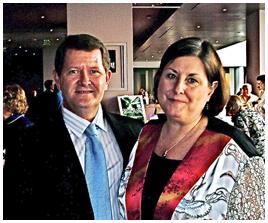 |
|
Rick
and his wife in 2009. |
|
Q) So what led to you getting a job with Marvel Productions?
Rick Hoberg: During a very short stint at an advertising
agency, I had been talking with a few comic book editors. Roy
Thomas (of Marvel Comics) was moving out to California. He wanted
to get a group of guys that he could work with out here. He really
wanted a stable of his own away from the Marvel guys, even though
he was still working for Marvel, so I became one of them. I did
quite a bit of work for him for a variety of things. That’s where I got the original Star Wars work and that was really a catapult for me. It really solidified my place in comics. From there on I got quite a bit of work. I did
What If…, some Conan stuff,
Kull, etc.. A lot of things overlapped at this time. I ended up getting a call from Doug
Wildey at Hanna-Barbera and went to work with him on
Godzilla and Jana of the Jungle. Around that same time I ended up doing
Super Friends as well. That’s where I learned my animated stuff…from Doug
Wildey. So I was balancing the two professions, although when I was in one, I was kind of out of the other. It’s pretty hard to do both. But that stuff lead to Marvel Productions.
Q) Were you working
at Depatie-Freleng before they became Marvel Productions?
Rick Hoberg: No. I saw a lot of that stuff. Fantastic Four is what you are thinking about?
Q) That and Spider-Woman.
Rick Hoberg: Spider-Woman I don’t know that much about. I think I saw the show once or twice but I remember watching
The Fantastic Four and wondered why there was a robot instead of the Human Torch in the show. [Laughs] But one of the most fascinating things to me when I got to Marvel Productions was that they had all of the original artwork from
The Fantastic Four. I had wondered why the show didn’t seem to flow as a story. It felt more like a bunch of pictures with no good
direction. It was because they had Jack Kirby doing storyboards for the show. Jack didn’t know what storyboards were. He didn’t understand the art form. He was doing them as comic books. There’s stuff that happens in comics that couldn’t happen in real time. For instance, a character like Spider-Man leaping across the panel, kicking some villains or punching while he says three or four lines of dialog. You couldn’t say that many lines of dialog in the time it takes to jump through the air and kick a bunch of guys. A lot of the comic book guys didn’t understand the difference. Probably because I grew up watching a lot of movies and cartoons as well as reading comics, I got the difference.
Q) So what did you work on when you began at Marvel Productions?
Rick Hoberg: The first show was the syndicated Spider-Man (1981). That’s why they hired me. It isn’t shown very often but a lot of it was really faithful to the character.
Q) Were you with the show from the beginning?
Rick Hoberg: Pretty much from the beginning. I think they had done one or two
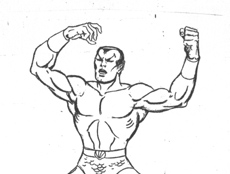 |
|
Rick's
design for Sub-Mariner |
|
episodes
before I came onboard. I became a storyboard guy and their main designer on it. I designed any of the Marvel characters from there on out, like the Sub-Mariner, Medusa…any of those characters that were Marvel based I was doing as faithfully as I could to the comics. Will Meugniot,
Larry Houston and I were real pests about it. We wanted this stuff to be
just like the comics! Believe me, the X-Men never would have even appeared in
Spider-Man and his Amazing Friends without us just pestering the daylights out of them.
|
Q) My understanding is that the 1981 syndicated
Spider-Man cartoon was made to be packaged with the 1967 Spider-Man
cartoon. Is that correct?
Rick Hoberg: No, I don’t believe it was. I don’t think so. They needed something up to date and that show didn’t work with the original Ralph Bakshi show that was done in the 60’s. But a syndicator could have done what they wanted with the material. They could have packaged them with the Bakshi show in your area. If they were selling them like that I may not have known because I wasn’t part of that.
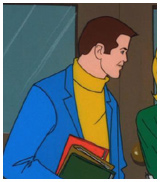 |
|
1967
Spider-Man cartoon |
|
Q) I didn’t have the shows in my area. I know Marvel owned the 1967 cartoon at the time and I’ve had people tell me they saw them together. It seemed possible because the 60’s show had 52 episodes. (13 of which were absolutely terrible with nothing but re-used animation.) The 26 episodes of the syndicated show could have brought the number to 65 or over, which was common for syndication at the time. Plus there is the choice to make Betty Bryant the romantic interest again instead of Mary Jane. And in some late episodes of the 60’s show, Peter is wearing similar clothes to what he is wearing in the 1981 syndicated show. He has a blue jacket and a yellow turtleneck. |
Rick Hoberg: That makes sense if the character looks the same…but gosh those shows were done ten years apart. They were really too different to put together.
Q) It could just be a weird coincidence. Since you came in a few episodes into the syndicated
Spider-Man cartoon, was that the reason the designs changed on some of the characters from this show to
Spider-Man and his Amazing Friends? For example, the Sandman and Magneto look different from show to show whereas most of the other characters do not.
Rick Hoberg: Yes, that’s very likely.
Q) I know John Romita Sr. was involved in the design for Firestar but what was the process of her final design?
Rick
Hoberg: That’s been MANY years ago now but I do recall that John had this design that was basically just a girl in a skin tight outfit and it was…Mary Jane, the classic Romita girl with the Mary Jane look basically. They needed it done so that they could use it for animation so I added the fire touches to it with the hair being a fiery effect and the areas where her boots and gloves are delineated from the rest of the costume. That’s where I came in. The final drawing, the final character is my character but it is heavily based on John Romita’s look. The original John Romita drawing had that Mary Jane hair; red hair with the Prince Valiant bangs.
|
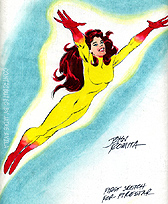 |
|
J.
Romita's first Firestar drawing
|
|
Q) I’ve always been disappointed that they never use your design for her hair in the comic books. It makes Firestar such a distinctive character to have the two-tone hair.
Rick Hoberg: Her hair was pretty stylistic. It wouldn’t have looked real good as a comic book thing. It was done for animation. Even with that, I was a novice when I was doing this. I was shooting in the dark when I designed it.
Q) People tend to think that Firestar’s alter ego, Angelica, was INTENTIONALLY designed to look like Mary Jane. Any truth to that?
Rick Hoberg: There was a reason for that: Stan Lee liked that look…but it’s just a classic John Romita character. If you look at Gwen Stacy…Gwen Stacy and Mary Jane are pretty much the same look. The hair is a little different but the face and the body are very much the same.
Q) There is a joke in an issue of the old Marvel comic, NOT BRAND
ECHH. It was illustrated showing how slight the differences in the designs of comic books women were at the time. The same drawing was used for each woman. The woman with red-hair was
a take off of Mary Jane. The drawing with blonde hair was a take
off of Gwen Stacy, etc..
Rick Hoberg: I’m not putting John Romita down at all because he is one of my favorites. I don’t think anyone in superhero comics drew girls as sexy as him.
Q) I’m not putting him down either. He’s one of my favorite artists too. I think the same situation applies to any comic book artist of the time. I just think people have, strangely, not considered that point. So do you think it was intentional that she looked like Mary Jane or do you think people think that because John Romita drew her?
Rick Hoberg: I think it was just an effect of John Romita designing her, to be honest with you. John got pulled into doing that stuff as did John
Buscema, who came out and did some designs for us at one point. And these guys were pretty much bored to death by this. They did it because Stan was paying them to do it. I don’t think they gave two shits about it. John was a very sweet guy and Romita was always very nice to me. I ended up ghosting the Spider-Man newspaper strip because I was sitting there and Stan wanted somebody he could put his hand on. I always got a great response from John
Romita, he was always very kind to me and he was a real “artist’s artist”. He knew how to talk to you and how to teach you as well. And John Buscema was a really nice guy as well but he just didn’t give a crap about animation. He came out and did it strictly for the dough.
Q) I never knew that you worked on the strip. How long did you work on it?
Rick Hoberg: I think I ghosted on it for a year and a half. I was working at Marvel Productions five days a week working on Spider-Man, Hulk, and
G.I. Joe then working on the strip on the weekend. It was a pretty brutal time for me. I was only working on the Sunday page for the strip but it is deceptively hard work. People think it’s an easy job but it is not. Trying to put an amount of story into seven panels is tough. I was ghosting so they wanted it to look like a cross between what Fred Kida was doing at the time and John Romita so you lose yourself in that. You don’t have any of your character in it. At a certain point I was burned out so I said to Stan, “I’m done”. I later hooked up with DC comics and they just loved my stuff. Within a year I was doing top name books for them. I took over ALL-STAR SQUADRON within six months of going to work for them.
Q) Let me test your knowledge of your time working on
Amazing Friends; how were the characters decided upon. Iceman, for example?
|
Rick Hoberg: They wanted to do a kind of Super Friends show.
Y’know, initially it was called Spider-Friends. That’s how they sold it, as “Spider-Friends.” They were going to do it under that name and it got changed to
Spider-Man and his Amazing Friends. Either name…I’m not sure which one is worse [laughs]. But they wanted us to do it much like the Super Friends and there was still this thinking that you’ve got to have a funny animal in it. That was imperative. It was horrible having the Ms. Lion character in
there, if you ask
|
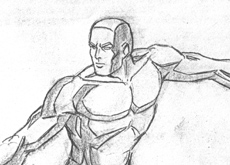 |
|
An
Iceman sketch by Rick |
|
me, but they felt it was a necessity. It was a way to sell it to NBC though and
Marvel really needed a show. They needed to prove themselves at that point.
Spider-Man and his Amazing Friends went two and a half seasons, which was pretty good at the time. It was no Super Friends but that was still really good. So the choices came about with them just deciding who would be good characters to work with Spider-Man. Spider-Man was thought of, at that point, as a teenager so they were looking for other teenagers and Iceman was always the perennial teenager of the X-Men. I’m going to guess that’s how they came up with him. Stan Lee and Dennis Marks (the producer) probably made the decision and, with
Firestar, I bet they thought the fire and ice thing worked well together.
Q) In the documentary
Spider-Man: On The Move, which was about the making of the show, Dennis Mark stated that the Human Torch was the original choice for the third character but he wasn’t used for fear that kids would play with fire because of his fiery look. That’s the same reason that got around that the character wasn’t used on the 1978
Fantastic Four cartoon. In recent years, it has been thought that the Human Torch was not available because someone had bought the rights to a Human Torch TV show.
Rick Hoberg: Any of that makes sense. But at that point there were these urban myths going around that kids were jumping out of two story buildings with Superman capes on. Now my parents bought me a Superman cape when I was a kid and I don’t remember being stupid enough to do something like that. So I just think it was that point in time where we had all of those shows, that were done in the 60’s, that were pretty faithful to the characters. We had semi-violent
Hanna-Barbera shows, like The Herculoids and Space
Ghost, and there was a backlash to it. The parent/teachers organizations said it was terrible for the kids because it was teaching them that violence was good. So the networks pulled WAY back…with their reaction being shows like
The Banana Splits.
Q) Since you designed the characters for Spider-Man and his Amazing Friends and were a comic fan, why did the Captain America villain, Dr.
Faustus, not look like he looked in the comic book?
Rick Hoberg: I’m coming up blank here. The name sounds familiar but I can’t think of the character.
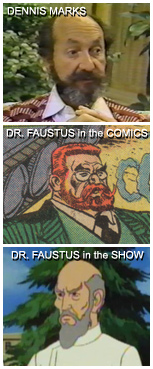 |
Q) Well, that may answer the question if you don’t know the character. In the comic book, Dr. Faustus is a fat man with red hair and a red beard. But in the show he is a slim older bald man with a grey beard and a mustache. He looks very similar to Dennis Marks who also did the voice for him.
Rick Hoberg: That makes perfect sense then. Dennis was a real character with a huge ego. Dennis had been hired by Stan Lee based of his work on a children’s show called
Wonderama. Dennis was from the school of the 1960’s
Batman show so he saw it all as campy. We artists, and when I say “we” I mean Will
Meugniot, Larry Houston, myself (and I would include Dick Sebast as well), we would constantly fight Dennis on this. We kept telling him that isn’t how these characters are. They’re not to be made fun of. You’re to have fun with them and you can certainly find humor in it…but he was always going for the camp. That’s why the Green Goblin, who he did the voice for, was like he was. None of us saw the Goblin like that. What he was trying to do there was a take on the Riddler or the Joker from the 1960’s
Batman show.
|
Q) I’ve heard stories that the network requested that Firestar’s breasts be toned down after the first season because her yellow jumpsuit would make her appear to be naked at times.
Rick Hoberg: They were really cautious. It actually had to be toned down quite a bit during the first season but every season they wanted it toned down more. Not as much on her breasts, because those we pulled back on right off the bat, but on her rear end. We actually had to take any semblance of a crack line out of it. So they didn’t even want to see a separation between the buttocks…which is how the legs work,
y’know? It looks kind of silly if you can’t animate that.
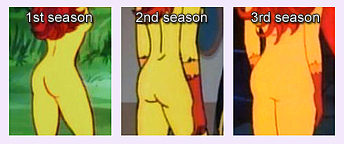 |
|
Baby
got...crack? |
|
Q) A Japanese animation company named Toei Doga animated four episodes of
Spider-Man and his Amazing Friends.
Rick Hoberg: Yes, they did and I think a couple of them were the X-Men appearances.
Q) They are the only one I’m familiar with. So, before we get into them, who were the other animation houses that did the other episodes?
Rick Hoberg: There was a Korean studio that Nelson Shin owned, the guy who was a partner with Lee Gunter at Marvel Productions. There were a lot of incestuous relationships in the business at that time. I think Dai Woo was the name of the company. Almost everything that came out of Marvel Productions was done by Nelson Shin…unless he didn’t have the time to do it. Either him or the other studio run by Steve Hahn, who I always related to the villain in
Enter the Dragon. [Laughs]. The guy was like a really cheesy oriental villain. His stuff was the worst. I worked in his studio on the first thirteen episodes on
Spider-Man and his Amazing Friends. I was sent over to be the supervising director in Korea.
There weren’t many episodes done by the Japanese (Toei Doga) because they were really expensive and Marvel was trying to make as much money as they could for themselves because they are a business. I think Nelson Shin’s company got busy working on the
Hulk, so Toei Doga was used for the second season of Spider-Man and his Amazing
Friends.
Q) I had always wondered why Toei Doga was not used for the third season of
Amazing Friends because their episodes, still to this day, look incredible.
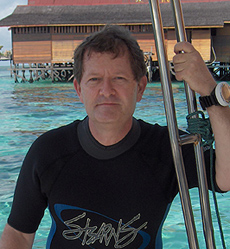 |
|
Rick on
vacation in 2009 |
|
Rick Hoberg: Are you kidding? We BEGGED them to use them. Again we were three guys fighting for this stuff. We were artists and fanboys and we were lucky enough to have Stan there who certainly wanted this stuff done well. So we would go to Stan…and it would piss off the other executives, but we weren’t going to get fired over it.
All they would do is say, “Shut up! Leave us alone!” It was a case of us getting away with a lot of crap by trying to get this stuff done as well as we could.
Will
Meugniot, especially, was well educated in the other studios so he was constantly trying to get them to make deals with them.
|
Q) Toei Doga was also used for the unsold
80's X-Men pilot, “Pryde of the X-Men”.
Rick Hoberg: Yes, and that’s the reason, because Marvel wanted something that was really “showy” to help sell it. Margaret Loesch and Lee Gunter, who was the head executive…these were great people. I would say, as executives, that they really revolutionized a lot of what happened in animation at that point.
X-Men was a showcase piece and they couldn’t trust the Koreans to do it at that point in time. They’ve done some great stuff in recent years but, at that point, the Koreans were doing mediocre stuff.
Q) Did you also do the designs for the 1982
Incredible Hulk cartoon?
Rick Hoberg: Yeah, I designed most of the main characters including the Hulk and other characters as we went along. I was heavily involved in it. They force you to do characters that you’re not nuts about. Like the cowboy version of Rick Jones was not really what I wanted to do but they were doing the show pretty faithfully. Even Stan, at times, was willing to go with the flow. It took a lot for us to be able to call the character “Bruce Banner”. They wanted the character to be called “Robert Banner”.
Q) What were your feelings on the decision to have Banner’s clothes reappear after he changed back from being the Hulk?
Rick Hoberg: That was something that we all hated. I constantly questioned that nonsense anyway. But it was something that we couldn’t stop because it was an easy way to get out of doing anything about it. It was a way to NOT have to explain. Even today we have set models for characters, just like back then, so it was easier to have the clothes reappear than it was for him to go out and get a pair of clothes that looked exactly like what he had on before. They certainly weren’t going to redress the character. That never would
have happened.
Q) So what ultimately happened to Marvel Productions? Why does the company no longer exist?
Rick Hoberg: They ran out of business. Back then you had to continuously sell stuff and there came a time when they weren’t selling anything. They had to close up shop. It was really common in Hollywood that a shop would close up and re-open as something else. Marvel Productions died, but just a few years later Marvel Films started up with the
Spider-Man show that Fox bought.
Q) So what are you working on now?
Rick Hoberg: Actually I am storyboarding on the Marvel Avengers shows. Marvel is co-producing it over at Film Roman. It’s a terrific show. I can’t say enough about it. They’re starting right from the beginning with Thor, Captain America, Iron Man, the Hulk, Ant-Man and the Wasp. Just a great show.
Q) How long have you been working on it?
Rick Hoberg: Gosh, I’ve been going on a year and a half now.
Q) What's the projected date for it? |
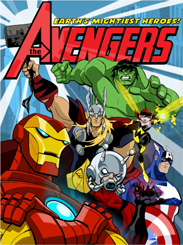 |
Rick Hoberg: I’m going to guess the fall or beginning of
2011 because they’re going to want to get ahead of the
Thor and Captain America movies. But this is right in line with that stuff. All of the characters are right on the money. The Iron Man character is really right in line with the Robert Downey Jr. character in the movie and the comic book character as well. Every episode I get to work on is fun and the guys really love this stuff. It’s really fun to collaborate with people who love the material. That’s part of the real enjoyment of my work: I’ve always been a collaborator. There are many guys in my business that say, “Why don’t you write and draw your own stuff?” My reaction is that it’s really fun for me to bounce ideas off of people. That’s what I’m getting on this show. There’s a lot of creativity going into it. Every time I get their idea’s I go, “Wow, that’s cool!” That’s all I really want out of this: something that’s enjoyable to work on and something that’s inspirational in a storytelling way.
Q) Rick, it was a pleasure talking with you. I’m looking forward to seeing
The Avengers and what you work on in the future! Thanks for doing this!
Rick Hoberg: Not a problem. It was good talking to you again.
Excelsior!!

|
|